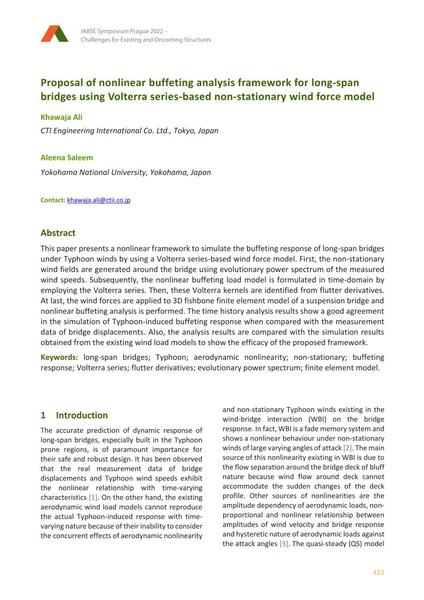Proposal of nonlinear buffeting analysis framework for long-span bridges using Volterra series-based non-stationary wind force model

|
|
|||||||||||
Bibliographic Details
| Author(s): |
Khawaja Ali
(CTI Engineering International Co. Ltd., Tokyo, Japan)
Aleena Saleem (Yokohama National University, Yokohama, Japan) |
||||
|---|---|---|---|---|---|
| Medium: | conference paper | ||||
| Language(s): | English | ||||
| Conference: | IABSE Symposium: Challenges for Existing and Oncoming Structures, Prague, Czech Republic, 25-27 May 2022 | ||||
| Published in: | IABSE Symposium Prague 2022 | ||||
|
|||||
| Page(s): | 423-430 | ||||
| Total no. of pages: | 8 | ||||
| DOI: | 10.2749/prague.2022.0423 | ||||
| Abstract: |
This paper presents a nonlinear framework to simulate the buffeting response of long-span bridges under Typhoon winds by using a Volterra series-based wind force model. First, the non-stationary wind fields are generated around the bridge using evolutionary power spectrum of the measured wind speeds. Subsequently, the nonlinear buffeting load model is formulated in time-domain by employing the Volterra series. Then, these Volterra kernels are identified from flutter derivatives. At last, the wind forces are applied to 3D fishbone finite element model of a suspension bridge and nonlinear buffeting analysis is performed. The time history analysis results show a good agreement in the simulation of Typhoon-induced buffeting response when compared with the measurement data of bridge displacements. Also, the analysis results are compared with the simulation results obtained from the existing wind load models to show the efficacy of the proposed framework. |
||||
| Keywords: |
buffeting response finite element model long-span bridges flutter derivatives typhoon aerodynamic nonlinearity non-stationary Volterra series evolutionary power spectrum
|
||||
| Copyright: | © 2022 International Association for Bridge and Structural Engineering (IABSE) | ||||
| License: | This creative work is copyrighted material and may not be used without explicit approval by the author and/or copyright owner. |
||||
